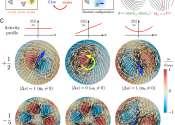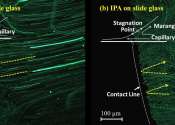In physics, a fluid is a substance that continually deforms (flows) under an applied shear stress, no matter how small. Fluids are a subset of the phases of matter and include liquids, gases, plasmas and, to some extent, plastic solids.
In common usage, "fluid" is often used as a synonym for "liquid", with no implication that gas could also be present. For example, "brake fluid" is hydraulic oil and will not perform its required function if there is gas in it. This colloquial usage of the term is also common in medicine and in nutrition ("take plenty of fluids").
Liquids form a free surface (that is, a surface not created by the container) while gases do not. The distinction between solids and fluid is not entirely obvious. The distinction is made by evaluating the viscosity of the substance. Silly Putty can be considered to behave like a solid or a fluid, depending on the time period over which it is observed. It is best described as a viscoelastic fluid. There are many examples of substances proving difficult to classify. A particularly interesting one is pitch, as demonstrated in the pitch drop experiment currently running at the University of Queensland.









